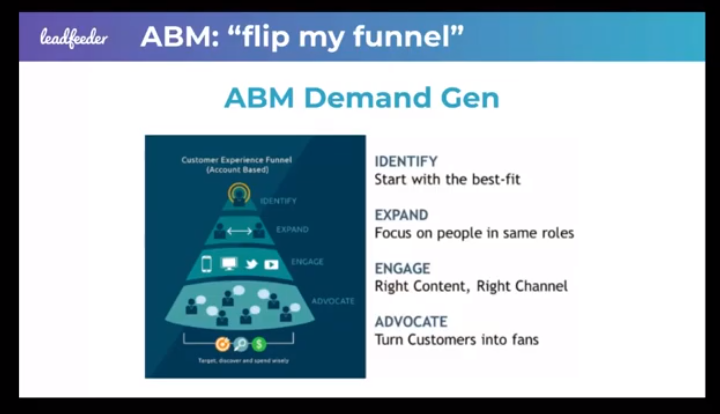Let’s not sugarcoat it. Generating leads is difficult.
Anyone who tells you otherwise probably thinks you’re a lead. And whether or not you believe them will determine how likely you are to become a conversion.
Ah, the sales cycle circle of life.
To further complicate things (or simplify, depending on how you look at it), lead generation in business to business (B2B) marketing is changing.
What once was up is now down — literally — as traditional lead generating tactics realign with the new strategic norm of account-based marketing (ABM).
Note: Make Leadfeeder a part of your lead generation 2.0 martech stack. See your leads now when you sign up for our free 14-day trial.
Traditional lead generation gets “flipped”
In traditional lead generation, the funnel starts broad and trickles down to isolate the most interested customers.
Awareness, interest, consideration, and purchase — you know the drill.
After creating awareness at the top of the B2B marketing funnel, you zero in on interest.
You drive people to your website’s landing page with the promise of value (i.e., downloadable content, an event RSVP, or newsletter subscription) on the other side of a submitted form.
ABM lead generation, on the other hand, asks you to recognize interested accounts from the start, as opposed to accounts revealing themselves based on the content you’re pushing out.
It removes random acts of marketing from the lead generation equation.

The flipped funnel driving lead generation 2.0 features a new set of stages:
Identify the people to engage with
Focus on a targeted list of companies
Engage people at those companies who are most likely to purchase
Create a loop from customer to loyal advocate
Identify. Qualify. Connect.
4 steps to building a successful lead generation 2.0 techstack
Whenever a new marketing strategy comes on the scene, there’s a lot of hype and buzz.
For B2B marketers, this is no different.
No one is arguing ABM’s effectiveness at this point. In fact, 87 percent of B2B marketers say that it has a higher return on investment than other marketing activities.
But many question the ease of implementation.
They wonder:
Do we have the resources? Do we have the budget?
With the right tech stack in place, bringing your company into the lead generation 2.0 era doesn’t have to be overly-complicated or expensive.
#1: Define your ideal customer profile (ICP)
Consider this the most difficult stage in the funnel. Once you know who your ideal customer is, the rest of the process falls into place.
To define your ICP, you’ll want to consider the following:
Firmographics (e.g., size, location, industry, function/growth, and all-commodity value [ACV])
Technographics (e.g., ABM tech and attribution, complementary software/partners, and competitors)
Intent (e.g., keywords and contextual search, and web visits)
Be conscious of whether the customer data platform (CDP) is identifying customer profile attributes based on first or third party data.
First party data, like that pulled by Leadfeeder, is collected directly from your audience (i.e. site visitors).
In comparison third party data, as HubSpot defines it, is collected by a business that has no direct link to the visitor or customer.
The former is more valuable to your business because it’s specific to your audience and the actions they take across your own digital assets (i.e. website).
During the first stage of building out your lead generation 2.0 techstack, consider using a tool like BuiltWith alongside Leadfeeder.
Pull a list of the companies using your competitors and compare them to those visiting your website. Any similarities will help determine your ICPs.
#2: Create your total addressable market (TAM)
With your ideal customer profile pinned down, you can start to develop your total addressable market. To do so, use a specific data point.
For example, let’s say you want to think in terms of who your competitors work with. Tools like BuiltWith and Dealfront are good starting databases.
BuiltWith is good for tech recognition. Find out what technology your website visitors are using at their companies.
You can essentially find every single account you could sell to based on the audience criteria pulled from these databases.
Create a list that’s as comprehensive as possible. This list can then be broken down by tiers relative to customer types and synced to your client relationship manager (CRM).
These tiers could be understood in terms of must-win, nice-to-win, or long-term win.
Or you could do what we do here at Leadfeeder.
For our sales and customer success teams, customer types are broken down based on revenue: top line, slightly less revenue, least revenue.
With a clear understanding of our cost per acquisition, we can allocate marketing resources to potential customers accordingly.
#3: Create and find relevant personas
Gather data around your accounts and you’ll inevitably understand your business model better over time.
Traditional lead generation tactics typically involve looking at things like gender, location, and/or age. But with the right tools in-hand, we can get even more granular.
To start building out personas, think about how many people you sell to in a sales cycle. For semi-complex sales, six tends to be the magic number.
Those people are then often broken down into two or three different departments with varying titles.
What are those job titles (e.g., sales enablement specialist, sales rep, Vice President of Sales, CRO)? What are the levels of people you’re selling to?
Then, use this information to guide your gathering of individual contact details through tools like LinkedIn Sales Navigator, LeadIQ or Dealfront.
Keep your personas simple and avoid categorizing them exclusively by job title. If personas are the overarching guidance, job titles are a subcategory within.
At Leadfeeder, we often see potential customers that fit with two to three different buyer personas.
Companies will then reach out to each with cold email templates based on the pages those visitors engaged with.
#4: Add in some personalization
Here is where you consider how to create meaningful content for each persona and where they fall in the sales cycle.
In terms of offline execution, a tool like Reachdesk syncs direct mailing efforts to your data and online marketing efforts.
When you send something physical (e.g., event tickets, a handwritten note, or gift), you can follow up digitally.
For online execution, a tool like Influ2 helps companies target people on an individual level with personalized ads distributed across various channels.
And of course, we’d be remiss not to mention Leadfeeder. Think of us as the gel that helps align marketing and sales from both a content and prospecting perspective.
We’ll help you continuously:
Identify which companies are coming in through the content being pushed out so you can create more content like it.
Identify which channels are performing so you can double-down on your efforts.
Give your sales development reps priorities around which customers to follow up with first.
Build more companies into your total addressable market (TAM).
See who hasn’t filled out a form to better gauge their interest.
A lead generation 2.0 techstack example
To round things out, let’s take a look at a possible lead generation 2.0 techstack you could employ across your B2B sales and marketing teams.
Here’s a list of potential tools and the functions they’d help serve:
HubSpot (CRM and marketing automation)
BuiltWith (TAM)
Leadfeeder (Intelligence)
Google, LinkedIn, and Facebook (Online execution)
ZoomInfo and LeadIQ (Contact data)
Influ2 (Personalization)
Reachdesk (Offline execution)

>>See the stack we use at Leadfeeder with more tips from our CMO on building your own
Final thoughts: Why lead generation 2.0 is the future of B2B marketing
Lead generation 2.0 is the future of B2B marketing because moments matter. Audiences need to be moved to take action, which means companies have to get smarter about when and how they connect.
Every journey is unique for the buyer making it — communicate with care.
Note: Make Leadfeeder a part of your lead generation 2.0 martech stack. See your leads now when you sign up for our free 14-day trial.
More leads, no forms.
Sounds too good to be true? It’s not. Identify companies already visiting your website and turn them into qualified leads to fuel your sales pipeline.
Show me how







